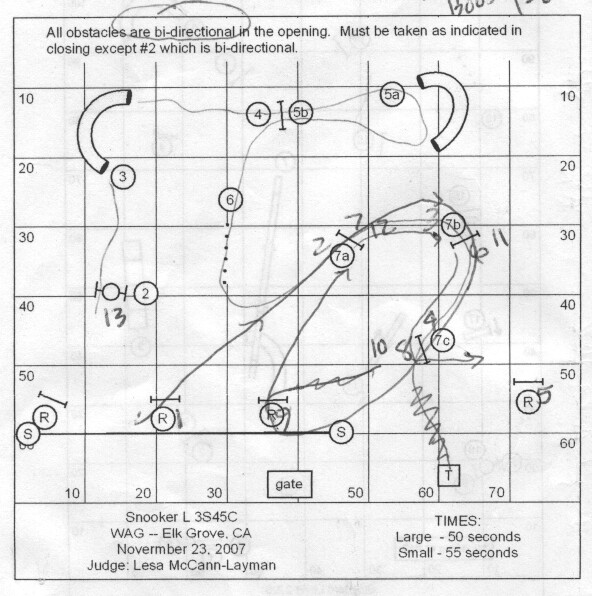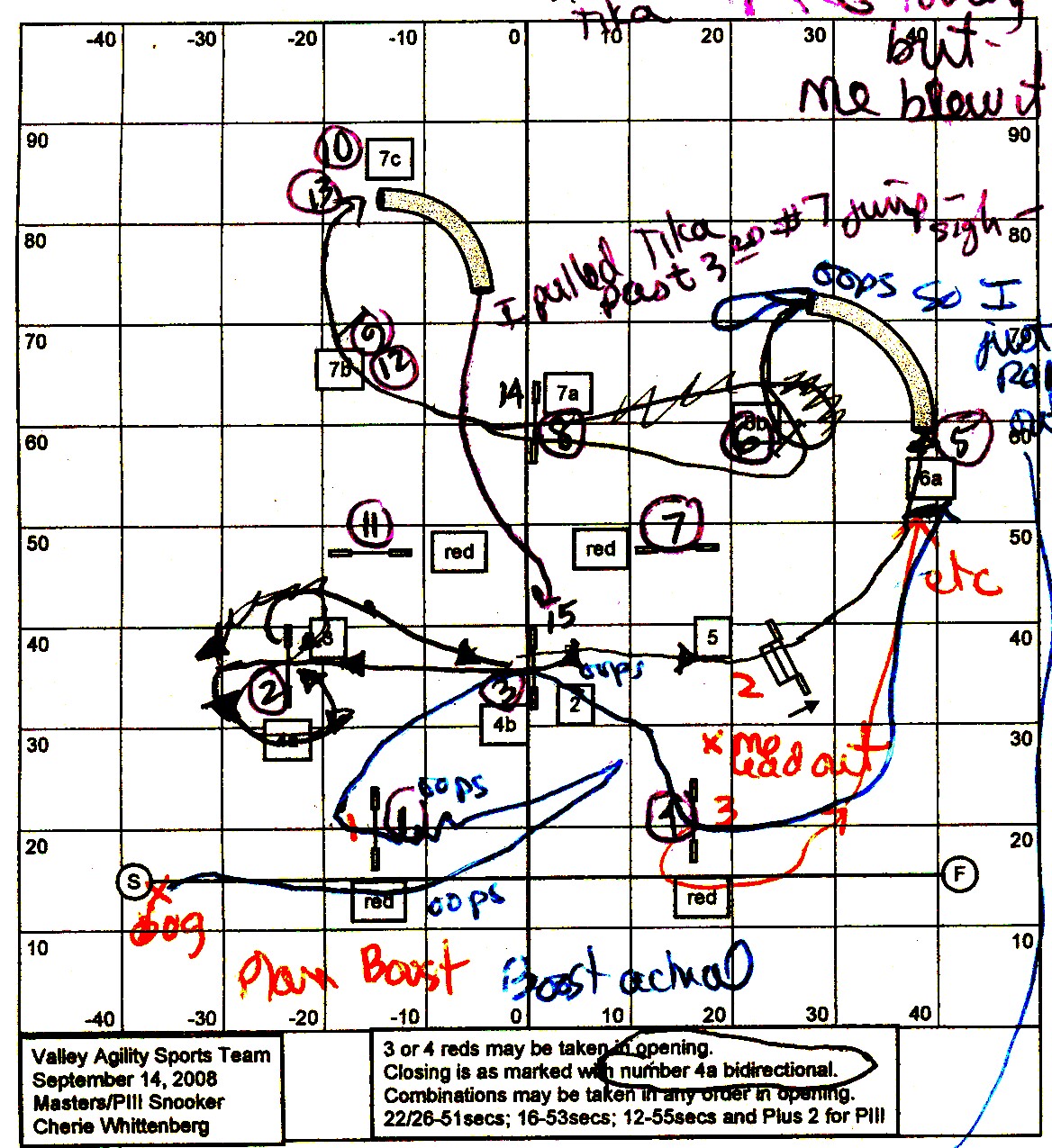SUMMARY: The rules of Snooker in dog agility.
Sometime back in Taj MuttHall's early life, I made a post about Snooker rules. But can't find it. And I've seen some questions on this topic, so let's address them here.
Isn't Snooker a billiards game?
Well, sure, if you want to do it in a smoky pool hall instead of out on the beautiful grass in the fresh air. However, understanding the original Snooker rules will make it VASTLY easier to understand agility Snooker rules. From Wikipedia's article on Snooker (pay attention, now):
It is played using a cue and snooker balls: one white cue ball, 15 red balls worth one point each, and six balls of different colours -- yellow (2), green (3), brown (4), blue (5), pink (6) and black (7). A player wins ... by scoring more points than the opponent(s), using the cue ball to pot the red and coloured balls in a predefined order.
At the start of a frame, the balls are positioned [in a specific layout] and the players ... hit a shot ... their aim being to pot one of the red balls and score one point. If they pot at least one red, then it remains in the pocket and they are allowed another shot - this time the aim being to pot one of the colours. If successful, then they gain the value of the colour potted.
[The coloured ball] is returned to its correct position on the table.
[Next, the player] must try to pot another red[, then one of the colours, and so on]. This process continues until they fail to pot the desired ball, at which point their opponent comes to the table to play the next shot. The game continues in this manner until all the reds are potted and only the 6 colours are left on the table; at that point the aim is to pot the colours in the [numbered] order. When a colour is potted in this phase of a frame, it remains off the table. When the final ball is potted, the frame is over and the player with the most points wins.
So what does this agility Snooker look like?
The course consists of three or more red jumps worth one point each, six other obstacles flagged with different-colored numbers -- yellow (2), green (3), brown (4), blue (5), pink (6) and black (7), and a cue ball--er, I mean, dog.
See where I'm going with this?
 (USDAA Masters, Feb 2007)
(USDAA Masters, Feb 2007)Waiiiiit a minute, I see a "5a" and "5b"; what's that all about?
OK, it would be pretty boring with really only 6 obstacles and three red jumps. Ya paid yer entry fee, you'd like to do a little more than that, eh? It's very common for a "numbered obstacle" to consist of two or sometimes three physical obstacles. So, to get 5 points, you must do the 5a AND the 5b.
What are the rules of agility Snooker?
You must take a red and complete it successfully (think of a knocked bar as missing getting the red into the side pocket; in that case, you can or must (rules vary) try a different red if you've not already used them all).
Then you attempt any 2-7 numbered obstacle. If you blow it (e.g., knock the bar or pop the contact), that was your chance to get the numbered ball into the side pocket and you muffed it.
Now you must do a DIFFERENT red (remember the first red ball went into the side pocket and stayed there; you can't use the same one again), then attempt ANY 2-7 numbered obstacle (whether you got it into the side pocket last time or not, it is returned to the table for you to use again).
Repeat a 3rd time. Depending on the rules, repeat a 4th time.
Now you've used all the red balls on the table; now you must sink the 2 through 7 balls, in order. If you hit one and miss (e.g., pop a contact), or if you sink one out of order (e.g., go from obstacle 2 to 5), that's it, your turn is over, you get whistled off the course.
In billiards snooker, there is no time limit. However, in dog agility, you must do everything that you're going to do within a time limit. When the whistle blows, that's it, you're off the course. (Time is typically 50-60 seconds.)
There ya go. Any further questions?
Why are there only three red 1-point jumps on the agility Snooker course?
Fifteen would be too many, really, now, wouldn't it? Because they don't disappear (like in billiards snooker), you AND the judge have to keep track of which ones you've already done. And we and the judge sometimes have trouble keeping track of just 3--picture the judge doing 200 dogs and trying to remember which reds a dog has used if there are 15 red jumps. Ha! Would be good for a laugh or two.
Sometimes in USDAA the judge uses 4 red jumps and either prohibits, allows, or requires you to take all 4. Some judges used to sometimes show up with courses with 6 or more red jumps, but I've heard that USDAA has put the kibosh on that.
In CPE, there are always 4 reds but you may complete only 3 of them.
Back to those multiple-obstacle obstacles--Can more than one of the point-value obstacles consist of multiple physical obstacles?
Sure, why not, the judges like to have fun designing the course.
In fact, the SAME physical obstacle could be worth DIFFERENT point values depending on which direction you take it (maybe one way is harder) or by combining it with different obstacles.
In the following course, to get 7 points, you must do 7a, 7b, and 7c. To get 5 points, you must do 5a and 5b. Note that the jump between the tunnels, if you take it by itself, is worth only 4 points, but if you combine it with the tunnel, it's worth 5 points. Trickyyyyyyyy.
 (CPE November 2007)
(CPE November 2007)That seems like it could be confusing.
Well, yeah. You need to carefully plot out your course and memorize it based on your chosen path through the obstacles and not try to wing it.
Here's the one we did last weekend (if you can read the obstacles through my scribbles); it's nothing but jumps and tunnels, and several of the "obstacles" are combinations-- (obscured by scribbles, sorry--3 is the jump after 2, going left; 4a is the same jump going right; 6b is a jump).
 (USDAA Masters, September 2008)
(USDAA Masters, September 2008)Do you have to take an obstacle in a specific direction (e.g., left to right but not right to left?)
Reds are always bidirectional: Take in either direction.
Colored obstacles usually place the number on the side from which you must approach it during the closing (doing 2-7 in order). Usually, colored obstacles are bidirectional in the opening, but not always (judge's choice). Usually, colored obstacles are one-directional in the closing, but not always (judge's choice).
That's why it's important to go to the Snooker briefing!
Can I see more Snooker course maps please?
Sure, here are previous ones I've posted.
CPE Snooker:
March 2008
CPE Nationals 2006
USDAA Snookers:
Masters, June 2006
Team Snooker, April 2008
Copying comment from unrelated post:
ReplyDeleteHey Ellen...
there are some obscure things to be aware of with snooker. (I just checked the rules cause I thought they weren't covered, but they are)
1) opening: 3 obstacle combo, allowed by judge in any order. Your dog does two, and then backjumps one you already did. Is there a way to continue, if so how?
2) opening: Your dog does a red, then goes between the tire frame and the tire. What is the correct next behavior? Hint: same question if dog goes thru the broad jump not between the poles.
3) Same as 1) but backjumps after doing all 3 of the combo. Is there any way to continue?
4) Just to point out the confusment: same as 2), except dog misses a contact on a dogwalk/aframe, or flys off the teeter. Or knocks the bar on a colored.
5) same as 2) except dog leaves the teeter before the descent.
Most of these are understood by understanding what's a refusal.
Except for the combo-performance rule, which is specific to snooker
(right? I think?)
-kevin
Response:
ReplyDeleteYou're correct, there are all kinds of edge cases that I didn't want to get into--the post was long enough already!
The first basic rule in the opening is that you must COMPLETE the colored obstacle, whether you have FAULTED it or not. For example, if it consists of 2 jumps and you knock the first one, you must still do the 2nd one. You won't get points for it, but you must complete it.
As you note, a REFUSAL means that you have not yet completed the obstacle. So: If you dog is going up the Aframe and bails, that's a refusal; you must redo the Aframe from the same direction. If your dog is going down the Aframe and bails, that's a flyoff and a fault, you don't redo it.
In your numbered examples:
1) The dog hasn't yet completed the numbered obstacle (because it consists of 3 parts); dog must complete all 3 parts. Think of it as bailing off the Aframe on the way up (but you don't redo all 3--just the one you missed).
2) Must redo the tire--probably from the same direction you tried before (as in the Aframe refusal).
3) After doing all 3 parts, the dog has completed the numbered obstacle. Now, when he retakes one of those parts, he's off course and whistled off.
4,5) I mostly covered those above already. I remember one course where the 7-pointer was a jump/12 weaves/jump and I did that in the opening and my dog knocked the first jump and just tearing my hair because I had to spend the time doing all those weaves and the other jump to complete the full obstacle to earn the right to go on to my next red (or the closing, whatever it was). On the teeter, if the teeter hasn't passed the point where it's titled towards the end instead of the beginning, it's a refusal & you must reattempt.
Oh, good, now I can send folks over here! Thank you for the great detail.
ReplyDeleteQuestion....In opening you have completed 3rd red jump and are using #2 jump for obstacle and you drop the bar.....you are now ready for closing and would repeat #2 again(bar is down) how does this work? I understand you dont get points for opening..but how does it apply for closing?
ReplyDeleteYes, you would have to repeat #2. In USDAA, *usually* you just go ahead and do it and you get the 2 points even though the bar is down (I think this depends on the judge, but usually they play it that way). In CPE Snooker, you're now dead and have to leave the field. I don't know how UKI Snooker counts that. I'll have to investigate.
DeleteUKI judges it the same as in USDAA. You go through the uprights to get the points even if you knocked the bar in the opening.
Delete